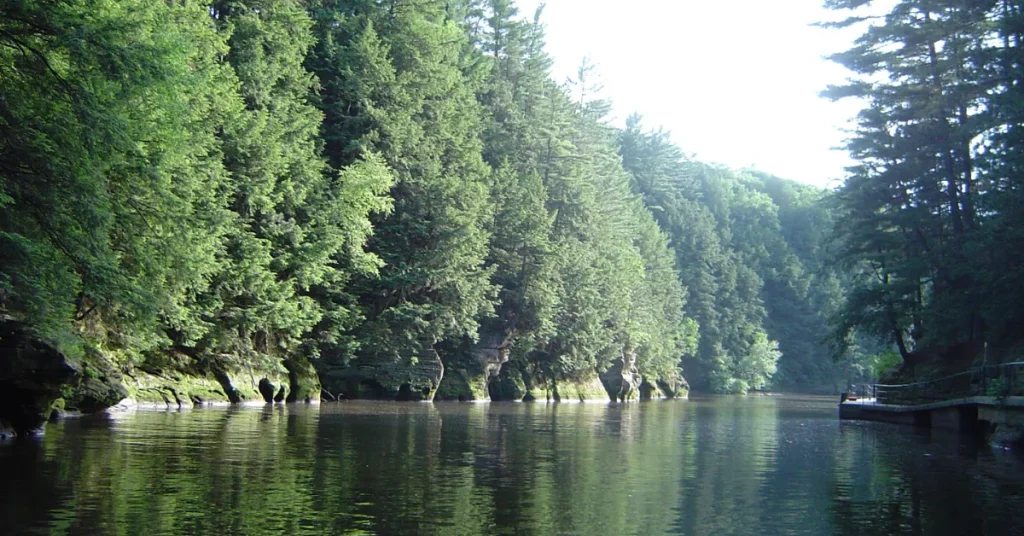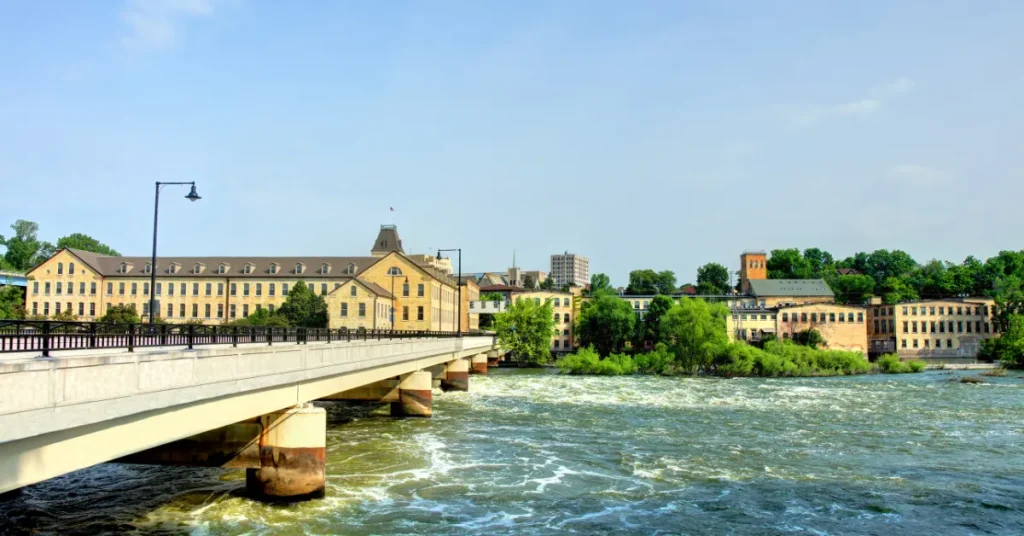The Wisconsin River has an average depth of about 4 to 5 feet. Depths can reach up to 25 feet in some areas.
The Wisconsin River is a staple feature of the Midwestern United States, charting a course through the heart of Wisconsin.
With a length of approximately 430 miles, this river’s flow is essential for the local ecosystem and recreation. Its varying depths accommodate numerous activities such as fishing, boating, and water sports.
The river’s dynamic nature makes it a point of interest for both residents and tourists, offering scenic landscapes and a testament to the natural beauty of Wisconsin’s geography.
As a critical water resource, the Wisconsin River plays a pivotal role in supporting the surrounding communities, wildlife, and also contributes to the state’s water management strategies.

Plunging Into The Wisconsin River’s Depths
Embark on a journey of discovery into the depths of the Wisconsin River. This majestic waterway, cutting a path through the heart of Wisconsin.
It holds secrets beneath its surface—secrets that are both fascinating and crucial for nature enthusiasts and geographers alike. Unveil the river’s underwater contours as we delve into its varying depths.
Charting The River’s Course
Meandering through the state, the Wisconsin River stretches over 430 miles, starting from the border of the Upper Peninsula of Michigan to its confluence with the mighty Mississippi.
At various points, the depth of the river differs, influenced by several factors such as the riverbed composition and water flow.
- Rhinelander: The depth starts at a modest 3-5 feet.
- Wisconsin Dells: Depths can reach up to 25 feet.
- Prairie du Sac: Before the dam, depths average around 12-15 feet.
Geographical Factors Affecting Depth
Several geographical elements play a pivotal role in shaping the Wisconsin River’s depths. The age-old dance between the land and water, carving out the riverbed, leaves impressions that sway the depth drastically from place to place.
| Factor | Impact on Depth |
| Glacial History | Glaciers carved deeper sections. |
| Rock Formations | Natural formations can create pools and gorges. |
| Sediment Buildup | Sediments accumulate, altering depth over time. |
| Human Activity | Dams and development can cause depth variations. |
Exploring the Wisconsin River is a unique experience due to its dynamic depth profile—a profile sculpted by nature and time.
Historical Tales Of The River’s Depths
The Wisconsin River, with its meandering path through lush landscapes, holds secrets beneath its waves.
Stories from the past give life to its depths. These tales speak of times gone by and the people who first encountered this majestic river.
Delve into the historical stories and understand the river’s significance through the eyes of those who lived alongside it.
Native American Folklore
Myth and mystery surround the Wisconsin River as Native American tribes have passed down stories for generations. The river was not only a source of sustenance but also a spiritual entity.
- Legends tell of spirit animals guiding fishermen.
- Ancient beliefs highlight the river’s depth as a passage to other worlds.
- Rituals performed on the riverbanks signify reverence for its power.
These rich narratives paint a picture of a river deeply respected by its earliest inhabitants.
Early Settler Accounts
As European settlers arrived, the Wisconsin River revealed new stories. These settlers viewed the river as an avenue for exploration and trade.
| Year | Account | Depths Recorded |
| 1800s | Journals describe perilous travels across variable depths. | Some areas reported to be over 40 feet deep. |
| Early 1900s | Commercial logs detail the river’s role in industry. | Shallow areas hindered navigation during dry seasons. |
These first-hand encounters provide insight into the challenges faced by those navigating the Wisconsin River’s unpredictable depths.
Modern Measurement Techniques

Diving into the depths of the Wisconsin River turns more precise with modern measurement techniques.
Advancements in technology have made it possible to obtain highly accurate depth profiles. These methods pave the way for a deeper understanding of this majestic waterway.
Hydrographic Surveying Tools
Experts use cutting-edge tools to measure water depths. These tools help to create detailed images of the riverbed. Some key instruments include:
- Multibeam echosounders – Send sound to the river floor and record echoes.
- Single-beam sonars – Provide a continuous depth recording along a line.
- Side-scan sonars – Offer images of large areas of the river bottom.
- Sub-bottom profilers – Reveal layers of sediment beneath the bed.
These advanced tools enable data collection even in challenging conditions. They ensure comprehensive coverage of the river’s depth and shape.
Data Analysis And Depth Mapping
The data gathered from these tools undergoes thorough analysis. Experts use special software to interpret the findings. The process includes:
- Compiling the data from different instruments.
- Removing inconsistencies and noise from the data.
- Integrating data into a coherent depth model.
This data becomes a depth map. A depth map is like a road map for waterways. It shows captains where they can safely guide their boats. It also helps scientists understand the river’s health.
Interactive charts and 3D models come from this data. These tools allow for better visualization and easier navigation of the Wisconsin River.
The Fluctuating Depths And Environmental Impact
The Wisconsin River, a vital waterway, weaves through the state’s landscapes with a depth that dances to the tune of nature and human activity.
Understanding the ebbs and flows of its waters reveals not only its natural beauty but also the potential environmental impacts these changes hold.
Seasonal Water Level Changes
The Wisconsin River’s depth is never constant. Seasons bring change, with each having a unique signature on the water levels. The river responds to the dance of climate, swelling with spring’s thaw and receding in the dry embrace of summer heat.
- Spring: Melting snow and ice feed the river, often raising levels.
- Summer: Evaporation and reduced rainfall may lead to lower depths.
- Fall: Consistent rainfall can replenish the river.
- Winter: Ice formation can obscure true depths.
Human Interventions And Ecological Effects
Where nature zigzags, humans draw straight lines. Dams and levees reshape the Wisconsin River, often with serious ecological consequences.
| Intervention | Impact on River Depth | Ecological Effect |
| Dams | Raise upstream, reduce downstream | Altered habitats, disrupted migration |
| Levees | Stabilize sections | Reduced flooding, wetland loss |
| Withdrawals | Lower levels | Stress on wildlife, water quality |
The balance between human needs and the river’s health stands on a precipice. Careful management and respect for the natural rhythms of the Wisconsin River are keys to preserving its splendor for generations to come.
Navigating The Depths: Implications For Recreation And Commerce
The Wisconsin River serves as a vital artery for both leisure and trade. Its depth variations offer unique opportunities and challenges.
These conditions shape how locals and visitors interact with the river. Let’s explore the impact on boating, fishing, and local economies along this majestic waterway.
Boating And Fishing On The Wisconsin River
Boating and fishing thrive on the Wisconsin River. Depths vary significantly along this watercourse, creating diverse habitats for fish and safe passages for boats.
| Section | Depth (Feet) | Boating | Fishing |
| Upper River | 3-5 | Suitable for small crafts | Abundant smallmouth bass |
| Middle River | 6-12 | Ideal for larger boats | Popular for walleye fishing |
| Lower River | 10-25 | Perfect for all boat types | Excellent for catfish |
Anglers and boaters should check local charts for depth details. Dense underwater vegetation in shallower areas can affect navigation and fishing tactics.
Impact On Local Economies And Industries
The Wisconsin River’s depths have a direct correlation with economic prosperity in riverside communities.
- Tourism drives revenue during the fishing and boating seasons.
- Commercial transport along the river supports local industries.
- Marinas and boat rentals depend on navigable waters for their business.
- Restaurants and shops benefit from visitors seeking the river experience.
Stakeholders, including policy makers and conservationists, must work together. They ensure the river’s health and navigability for sustained economic benefit.
Conservation Efforts And The Future Of The River’s Mysteries

The Wisconsin River, with its diverse ecosystems and rich history, is a treasure trove of secrets yet to be fully uncovered. As interest in the river’s depths grows, so do efforts to protect its intricate and mesmerizing world.
Conservation plays a vital role in ensuring that the future generations can continue to discover the river’s mysteries.
Protecting The River’s Biodiversity
Efforts to safeguard the biodiversity of the Wisconsin River are in full swing. The river is home to a wealth of species, some found nowhere else in the world.
Conservation programs focus on maintaining clean water and protecting habitats. This work is crucial for the survival of native fish, birds, and plant life.
- Enhanced water quality monitoring
- Habitat restoration projects
- Prevention of invasive species spread
Ongoing Research And Educational Initiatives
Understanding the Wisconsin River is key to its preservation. Ongoing research dives into the complex interactions within the river’s ecosystems.
Scientists and local universities continually study the river’s health. They monitor species populations, water quality, and the effects of climate change.
Educational initiatives aim to inspire locals and visitors. Outreach programs stress the importance of the river to Wisconsin’s natural heritage. The future of the Wisconsin River depends on the continuous growth of these efforts.
- Collaboration with educational institutions
- Interactive workshops with local communities
- Public awareness campaigns
FAQs About How Deep Is The Wisconsin River
What Is The Average Depth Of The Wisconsin River?
The average depth of the Wisconsin River is about 6 to 12 feet. However, it can vary depending on the location and season. Areas near dams are often deeper.
Can You Swim In The Wisconsin River?
Swimming in the Wisconsin River is possible, but caution is advised due to varying depths and currents. Always check local conditions and regulations before swimming.
Where Is The Deepest Point Of The Wisconsin River?
The deepest point of the Wisconsin River is near the Prairie du Sac Dam. Depths here can reach up to 35 feet or more. It creates deeper waters for fishing and boating.
How Does The Wisconsin River Depth Affect Boating?
The Wisconsin River’s depth influences where boats can travel safely. Shallow areas may be hazardous. Always consult river maps and local advisories for safe navigation.
Conclusion
Exploring the depths of the Wisconsin River reveals an incredible journey through nature’s artwork.
With variations ranging from shallow riffles to profound channels, this river caters to both adventurous spirits and those seeking tranquility. Remember, its depth is ever-changing, much like the river’s own meandering story.
To experience its full majesty, see it for yourself. The Wisconsin River awaits your discovery.
Resources:
1. https://www.rivers.gov/wisconsin
